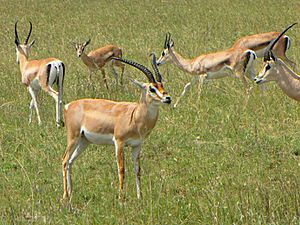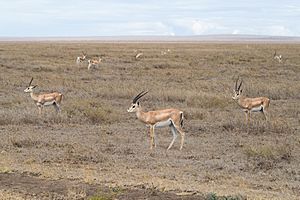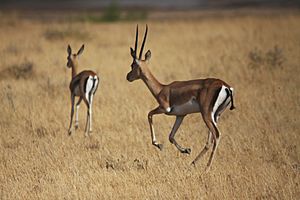Grant's gazelle facts for kids
Quick facts for kids Grant's gazelle |
|
|---|---|
 |
|
| Conservation status | |
| Scientific classification | |
| Kingdom: | |
| Phylum: | |
| Class: | |
| Order: | |
| Family: | |
| Subfamily: |
Antilopinae
|
| Genus: | |
| Binomial name | |
| Nanger granti (Brooke, 1872)
|
|
The Grant's gazelle (Nanger granti) is a species of gazelle. It lives in many parts of East Africa. Its Swahili name is Swala Granti. It is named after explorer James A. Grant.
Description
The Grant's gazelle stands 75–95 cm (30–37 in) tall. The females weigh between 35 and 50 kg (77 and 110 lb) and males weigh between 50 and 80 kg (110 and 180 lb). Its coat is a beige orange on the back with a white belly. The Grant's gazelle looks similar to a Thomson's gazelle, except for some distinguishing features, such as a different horn shape. Grant's gazelles are very fast.
The Grant's gazelle is found in East Africa. It lives in open grass plains and shrublands. They are well adapted to dry areas. They get most of their water by eating plants.
Ecology and behaviour
The Grant's gazelle is found in East Africa and lives in open grass plains and is frequently found in shrublands; it avoids areas with high grass where the visibility of predators is compromised. They also occur in semiarid areas and are relatively well adapted to dry areas, relying on more browse or leafy material during dry seasons to supplement their intake of water. They are migratory animals, but travel in the opposite direction of most of the other ungulates, such as Thomson's gazelles, zebras, and wildebeest, which are more water dependent. They can subsist on vegetation in waterless, semiarid areas, where they face little competition.
The most common predators of the Grant's gazelle are cheetahs and wild dogs. Humans also tend to hunt gazelles. In the Serengeti, Grant's gazelle is a prey item for cheetahs, but the Thomson's gazelle is preferred. However, in Nairobi National Park, Grant's gazelle is preferred over Thomson's gazelle, making it an important resource to the cheetah. Jackals are major predators of fawns.
The Grant's gazelle is a gregarious, territorial, and migratory species. The home ranges of does overlap with those of the bucks. Only male gazelles are territorial. Male gazelles will herd all females that cross their territories. When the females are in estrus, they are strongly guarded by the dominant male, which prevents other males from mating with them. Any doe that tries to leave is aggressively herded back. Most of the time, the buck’s simple stance in relation to her is enough to keep the female from leaving.
Bachelor groups are made up of adolescent and bucks not holding territory. Any new members must perform intimidation displays to enter the group. However, bachelor groups tend to be very loose and members can leave whenever they want.
The larger, older males with thick horns have the best chance of establishing a territory. Conflicts between adult males are usually solved with intimidation displays. The bucks circle each other and swing their necks from side to side, displaying their neck power. Neck strength is important in an actual fight and the male that cannot keep up yields. Gazelles of nearly equal neck strength are more likely to engage in actual combat. Fighting occurs in young bucks more often than older ones. Dominant bucks can simply run off subordinates rather than having to display to them.
Diet
Grant’s gazelles are generally mixed feeders that both browse and graze. Their average diet consists of 65.8% browse and 34.3% graze. Rainfall in their habitats seems to be the determinant of their diets. The Grant's gazelle's diet may also be responsible for the slow growth rates in the browsed plots. They get most of their moisture from the plants they eat, so they do not often have to drink water. Thus they can stay on the plains long after the rains end. From July to September, gazelles move deep into dense brush and wait for the next rains. They will eat red oats and small, tough plants, which are avoided by the other ungulates. This allows the gazelles to survive in the brush during the dry season. Grant’s gazelles eat mainly dicotyledons during the dry season and grass in the wet season.
Reproduction
Grant’s gazelles sexually mature at 18 months.
The gestation period for the gazelle lasts for 198 days.
Births peak in January and February. A doe will leave her herd and find a well-hidden place to give birth. The does nurse their fawns four times a day.
Fawns are immobile for the first few days, so the mother stays close by. When the fawn can walk, it leaves with its mother to find a herd. Around this time, fawns will associate with one another in peer groups.
A gazelle is weaned at six months, but will continue to associate with its mother until adolescence.
Images for kids
-
A skull of male exhibited at the Smithsonian National Museum of Natural History, Washington D.C.
See also
 In Spanish: Gacela de Grant para niños
In Spanish: Gacela de Grant para niños








